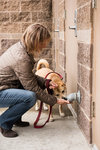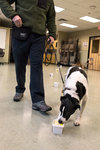

At the Humane Society for Southwest Washington (HSSW) in Vancouver, dogs zip between chairs and boxes in a sunny classroom, their tails held high and their noses aquiver.
When they catch a familiar scent their demeanor changes abruptly; they come to a sudden stop, take a final sniff to confirm, and turn eager eyes on their handler to say “I found it.” A “payment” of treats is doled out quickly, a reward for a job well done.
These dogs are engaged in K9 Nose Work, a sport first sanctioned by the National Association of Canine Scentwork (NACSW) in 2009. According to their website, “K9 Nose Work is designed to let dogs engage their natural scenting abilities in a fun and rewarding search endeavor.” The sport is designed to be as accessible to the highly motivated working dog as it is to a family pet.
Joyce Biethan, owner and CEO of Joyce’s Dogs in Ridgefield, has been training dogs for over 17 years. She discovered K9 Nose Work in 2009, and in 2011 became a Certified Nose Work Instructor (CNWI). She finds it addresses the needs of a wide variety of dogs, whether they are shy, environmentally sensitive, or sensitive about people.
“Dogs blossom because they are doing what comes naturally to them,” Biethan said.
Biethan teaches K9 Nose Work for the enrichment program at HSSW, which aims to keep dogs physically and mentally fit while they await adoption. According to Tara Zimmerman, Canine Enrichment Specialist for HSSW, “It’s safe and fun for any breed or age of dog, it engages their primary sense of smell, and it gives them a job to do.”
Because K9 Nose Work is an individual activity, it eliminates the risk of behavior conflicts between dogs.
“There are very few activities that the shelter can offer to such a diverse range of dogs,” said Zimmerman.
Shelter dogs are especially prone to stressed behaviors such as panting and pacing, which makes them less appealing to adopters looking for their next pet. But after they have participated in the K9 Nose Work program at HSSW, a dog’s whole demeanor changes. They are more relaxed, confident and outgoing, and most are adopted quickly.
HSSW volunteers attend a training workshop and then work in groups of four twice each week to provide K9 Nose Work activities for the dogs. As a team they can offer the activity for a dozen or more dogs in one session.
Since its inception in 2013, the program has served over 150 dogs. The training is also open to members of the public who would like to learn to practice K9 Nose Work with their own dog.
The first step in K9 Nose Work is teaching a dog to associate one of the proscribed scents – birch, anise, or cloves – with a favorite food or toy.
“We leave obedience at the door,” says Biethan.
Dogs are learning to direct their scent-seeking behavior, and the handler’s job is learning to recognize it. After a dog understands that finding a scent leads to rewards, the scent is concealed in a cardboard box and later an object like furniture. Dogs learn to search for scents outdoors as well, a task more difficult because of increased distractions but also simpler because the air movement makes scent detection easier.
For the avid K9 Nose Work fans, NACSW has sanctioned 135 K9 Nose Work trials in 17 states since inception. Before competing in a trial, the handler must be a member of the NACSW, the dog must be registered with the NACSW and have an NACSW scorebook, and the dog must pass an Odor Recognition Test (ORT). Nose Work trials offer classes with increasing levels of difficulty.
Biethan hosts a K9 Nose Work trial in Clark County when she can find a suitable venue to rent for a weekend. The ideal location is a school or office with 4-8 classrooms or meeting rooms, ample parking, and an outdoor search area. And, of course, a dog friendly attitude, though organizers work hard to leave the space in the condition they find it.
More information about K9 Nose Work is available at the NACSW website, atwww.nacsw.net.